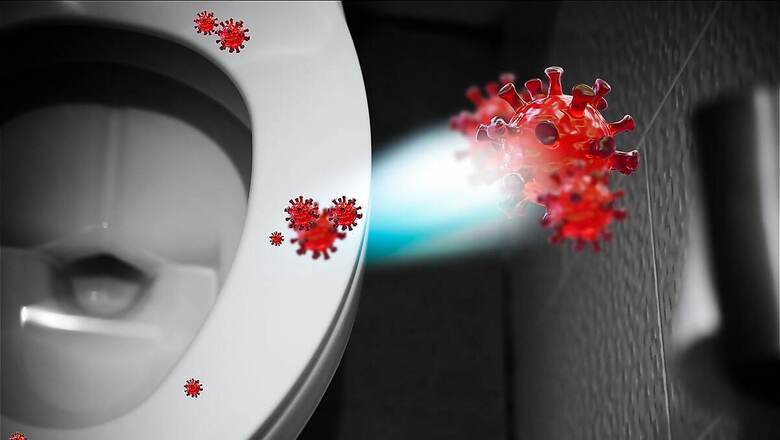
views
If you read that headline and sighed a little, we feel you. Anyone who has walked into a muddy toilet full of footprints on slick, slippery tile, knows exactly why monsoons are a miserable time to go to a public toilet. Everything is harder to keep clean in the monsoon, but public toilets are particularly hard.
However, unclean and poorly maintained public toilets can very quickly become health hazards. Dirty or damaged toilets can become breeding grounds for diseases, with standing water attracting disease-carrying vectors, and untreated waste contaminating our land and water. This pollution threatens all of us – even those of us who live in clean apartments with clean toilets. At the end of the day, we share our air, water and land with the larger community. Even when we live alone in apartments, our lives are enabled by a retinue of delivery boys, maids, security guards and others. Where does this support system (or at least a part of it) live? In slums. Where people rely on public toilets.
This becomes a particularly acute problem in cities where population density is high. We learnt this the hard way during the Covid-19 pandemic, when infection rates soared amongst our cities, while rural areas fared comparatively better.
Recognizing the significance of good sanitation practices, Harpic, a leading brand in lavatory care in India, has been at the forefront of advocating for improved sanitation. Collaborating with News18 through the Mission Swachhta aur Paani initiative, Harpic is spearheading a movement to promote inclusive sanitation, ensuring that everyone has access to clean toilets. With the advent of the monsoon, Mission Swachhta aur Paani is focusing on the specific challenges that the Indian monsoon poses to public toilets.
Common Diseases caused by poor sanitation and unclean toilets
Waterborne diseases
In India, children still succumb to diseases like Diarrhoea, Cholera, Typhoid, Amoebic Dysentery, Hepatitis A, Shigellosis, Giardiasis and many others. Every single one of these diseases is caused by ingestion of contaminated food or water, which then causes bacterial infections inside the body. In communities where toilets are dirty or damaged, or where municipal waste (which includes toilet wastes) is allowed to flow untreated into land and water masses, these diseases are increasingly common. In Cholera, the disease progresses rapidly, and can turn fatal in a matter of hours. Typhoid fever can last for 3-4 weeks. A person with Hepatitis A feels better after a whopping 3 months, that too, after significant care and nutrition.
Each of these diseases is entirely preventable through good toilet hygiene and maintenance. Absent, inadequate, or inappropriately managed water and toilets expose entire communities to these diseases.
Neglected Tropical Diseases:
NTDs are a set of infectious conditions that mainly impact those segments of society that are already the most vulnerable and impoverished. These infections are poverty-related and particularly abundant among people with limited access to safe water, clean toilets or adequate health facilities.
Diseases such as Lymphatic Filariasis, Visceral Leishmaniasis, Soil Transmitted Helminths, or Leprosy, are debilitating, disfiguring and stigmatising. They impact the lives of over a billion people worldwide, many of whom live in India.
Vector borne diseases:
Vector borne diseases like Malaria, Dengue Fever, Yellow fever, Chikungunya, are commonly seen in areas where good toilet sanitation practices are not followed, and where clean toilets either don’t exist, or are poorly maintained. Toilet sanitation isn’t just about cleaning the toilet bowl itself, but ensuring that the area surrounding it remains clean and dry. Any standing water attracts these vectors. Each of these diseases is caused by vectors who flourish in dirty standing water. Overflowing sewage is another common breeding ground.
A stitch in time: How a basic cleaning and maintenance routine can keep your toilet safe
To begin with, it is crucial to take preventive measures to stop the spread of germs and maintain cleanliness in toilets, particularly during the monsoon. Here are some tips to consider – for public toilets, and for your own toilets at home:
Regular Cleaning:
To keep toilets free from germs and maintain hygiene, it is essential to clean and disinfect them regularly. During the monsoon season, it is recommended to clean toilets at least twice a day to prevent the growth of bacteria and viruses. Start by flushing the toilet and then apply a good quality toilet cleaner, such as Harpic, to the bowl and under the rim. Allow it to sit for a few minutes before scrubbing the inside with a toilet brush. Pay special attention to the areas around the rim and the hinges. After scrubbing, flush the toilet again to rinse off the cleaner.
Remember to clean the seat, lid, and outer surfaces of the toilet as well, using a disinfectant cleaner. Regular cleaning and disinfection will help reduce the risk of infections and keep your toilet germ-free. Use a floor cleaner to cleanse the floors, and dry off any damp patches with a mop. Use the exhaust fan (if you have one) to encourage ventilation and air flow.
Drainage System Maintenance:
Clogged drains can be a breeding ground for bacteria and foul odours. Before the monsoon season begins, inspect the drainage system and ensure that it is free from any blockages. If you notice any issues, such as slow draining or foul smells, call a professional plumber to fix the problem promptly.
During the monsoon season, water seepage and leakage can be a major concern in toilets. It is important to ensure that your toilet has proper drainage and waterproofing to prevent water from seeping in and causing damage. Check for any leaks or cracks in the walls, floors, and pipes. If you notice any signs of leakage, such as dampness or water stains, take immediate action to fix them. It is advisable to hire a professional plumber to inspect your toilet and fix any issues related to drainage and waterproofing. By maintaining a well-sealed and leak-free toilet, you can prevent waterborne diseases and the growth of germs.
Adequate Ventilation:
Proper ventilation is crucial for maintaining a healthy environment in your toilet, especially during the monsoon season. Due to the increased humidity, toilets are prone to developing mould and mildew, which can lead to respiratory problems and allergies. Ensure that your toilet has a window or exhaust fan to allow for air circulation. If your toilet doesn’t have any natural ventilation, consider installing an exhaust fan to remove the moisture and prevent the growth of mould and mildew. Additionally, make sure to keep the toilet door open for some time after use to allow the air to circulate and dry out any excess moisture. Good ventilation will not only prevent the growth of germs but also help eliminate unpleasant odours.
Regular Disinfection:
In addition to regular cleaning, it is essential to disinfect the toilet regularly. Use disinfectant sprays or wipes to sanitise surfaces such as the toilet seat, flush handle, and doorknobs. Pay special attention to high-touch areas that are prone to the accumulation of germs.
Practising safe hygiene
Apart from maintaining a clean and safe toilet, adopting the right hygiene practices is equally important to ensure a germ-free environment and monsoon-proof toilets. Here are some basic practices you must encourage everyone in your orbit to follow.
Hand Hygiene:
Our hands go everywhere. So hand hygiene is crucial for preventing the spread of germs and infections, especially during the monsoon season when the risk is higher. Encourage everyone in your household to wash their hands thoroughly with soap and water after using the toilet, before meals, and after coming in contact with potentially contaminated surfaces.
At your workplace, if soap and water are not readily available, use an alcohol-based hand sanitizer to disinfect your hands. Place hand sanitizers near the toilet area and make sure they are easily accessible. In schools, it is important to educate children about the importance of hand hygiene and encourage them to develop good hand washing habits from an early age. Proper hand hygiene will significantly reduce the risk of infections and promote overall health.
Toilet Etiquette:
Promote good toilet etiquette among users to maintain cleanliness. Encourage users to flush the toilet after use and dispose of sanitary products and tissues in the designated bins. Remind users to avoid flushing any non-biodegradable items that can clog the drainage system.
At public toilets, it is important to have signage that is clear and understandable, even if users can’t read. Pictorial representations of which items can be flushed (and not flushed), where sanitary products can be disposed, and of course, where the soap/sanitiser is, go a long way in ensuring that the toilet hums along without avoidable interruptions.
Pest Control:
Monsoons often bring along an increase in pests – particularly if you’re on the ground floor. To prevent pests like mosquitoes and flies from breeding in the toilet area, consider implementing pest control measures. Use mosquito nets or screens on windows and doors, and use insect repellents or sprays to keep pests at bay.
Regular Inspections:
Conduct regular inspections of the toilet area to identify any potential hygiene issues. Check for leaks, malfunctioning flushes, or any signs of water accumulation. Promptly address any problems to prevent the growth of germs and maintain a clean environment.
For public toilets, this can take the form of a checklist that toilet attendants use on a daily and weekly basis.
Creating systems and processes that work
Particularly in the case of public toilets, if it isn’t someone’s job, it becomes no one’s responsibility. One of the most effective steps in keeping toilets clean and well-maintained is the appointment of trained toilet attendants.
Fortunately, Harpic started the World Toilet Colleges in 2016 with the two-pronged aim of creating a ready supply of well-trained sanitation specialists, and creating dignity and safety for sanitation workers through education. The college operates as a knowledge sharing platform with an aim to uplift the lives of the sanitation workers by educating them about their rights, health hazards, use of technology and alternate livelihood skills. Workers trained by the college are provided placement with various organisations. Following the successful proof of concept in Rishikesh, World Toilet Colleges have opened in Maharashtra, Aurangabad, in partnership with Harpic, Jagran Pehel and Maharashtra Government.
Toilet attendants improve toilets in many ways: during monsoons, toilet attendants can serve as an early warning system – by raising the alarm when things go wrong (or are about to go wrong, as in the case of flooding). Being the boots on the ground, they can also report the need for repairs and maintenance to the parties responsible for making these decisions.
Spreading awareness
When it comes to health and sanitation, creating awareness is a vital step. As we saw with the Covid-19 pandemic, effective communication about vaccination and social distancing saved millions of lives in India, and helped flatten the curve. In exactly the same way, communication about good sanitation practices and toilet hygiene, particularly during the monsoons, can have a ripple effect on rates of infection, reduced breeding of vectors, and of course, better infrastructure for treating our wastes, particularly, toilet wastes.
Mission Swachhta aur Paani, a 3 year old collaboration between Harpic and News 18, calls attention to the power of clean toilets in India. Clean and safe toilets for all means that our communities are healthier, our children spend more days in school and less days out sick, girls don’t drop out of school, our workplaces are more diverse places, and that our cities and towns are cleaner, safer, and more welcoming spaces.
Mission Swachhta aur Paani upholds the cause of inclusive sanitation where everyone has access to clean toilets. This means that toilets are equally accessible for all genders, abilities, castes and classes and that clean toilets are a shared responsibility. In order to get the word out, Mission Swachhta aur Paani is creating repositories of information that help you have the right conversations. Whether it is educating your children about toilet etiquette, or talking to your bosses at work about a gender inclusive toilet, or talking to your local ward officer about monsoon proofing your local public toilets – Mission Swacchta aur Paani has the information you need to make an impactful argument.
Join us here, to learn how you can contribute to this national conversation, and help create a society where clean, safe and welcoming toilets (even during the monsoon!) are the norm, rather than the exception.















Comments
0 comment